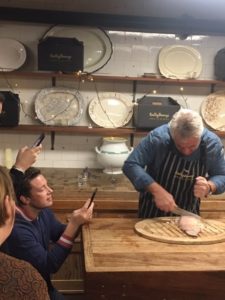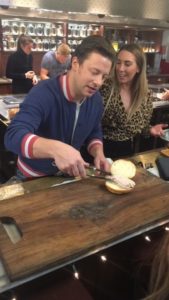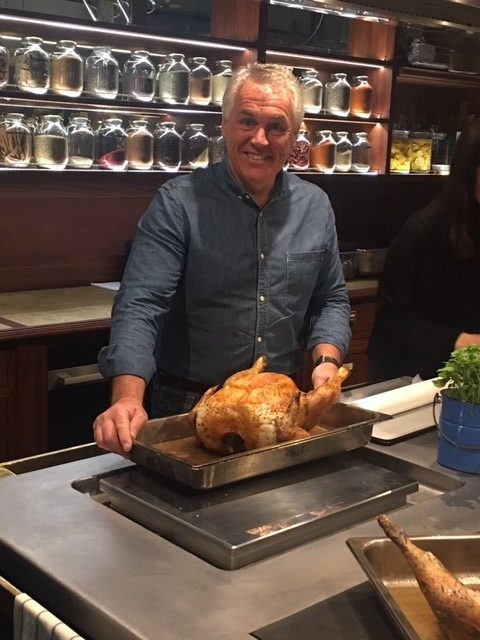Words by Lisa Currie
Turkeys for Christmas
With December already upon us and Christmas fast approaching, the British public are sure to be on the look-out for the all-important turkey to grace the centre of their Christmas feast.
Before we all charge off to Tesco’s frozen section, it’s worth considering your other options. Over the last five years or so more and more people have been turning to organic Bronze Turkeys. They aren’t cheap – reaching well over three figures for a big bird. But everyone who buys them claims they’re worth it. Turkey is usually considered a dull dry meat, but can it be that we’re all simply getting it wrong?
Paul Kelly, the proprietor of the now world famous KellyBronze Farm breeds only the very best free-range organic Bronze turkeys. He hosted an event at Jamie Oliver’s HQ recently and treated Tasting Britain to a masterclass in the art of turkey cooking and carving.
Jamie Oliver’s HQ is an ideal location for such an event. KellyBronze luxury turkeys sit on pristine marble worktops in an enormous restaurant-style kitchen, already cooked to perfection, watched from afar by the occasional BAFTA sat on a dusty window sill – surprisingly understated for Mr Oliver. Upon arrival, the drinks were pouring and the Christmas music playing. Very festive indeed. We all gathered round eager to hear the facts and the figures in a demonstration by Paul, who unsurprisingly holds the Guinness world record title for fastest turkey carver. After an introduction by Jamie, who explains his desire to support small-scale producers by giving them a platform to showcase what they do, Paul takes charge and quickly makes it very apparent why we should take more care of how we cook our turkeys and from where we should source them.

All I want for Christmas is…a turkey?
For as long as we can remember, turkey has been the meat of choice for the festive period. We have King Henry VIII to thank for this. He first bought turkey to the Festive table in 1534 and as the masses followed their leader, it rapidly became the popular choice for Britain’s Christmas grub. So much so that turkeys were walked from across the UK to London each year in a journey that took more than three months, to get to hungry consumers in time.
Fast forward to the 1950s and Kelly explains the shift to white turkeys due to huge rises in British consumption and increases in mechanisation, which drove mass production to the fore, replacing more traditional farming methods. The whole bronzed turkey was replaced by the white turkey, and then by the white turkey crown, deemed more aesthetically pleasing and cheaper for consumers. Fast and frozen became fashionable and supermarkets began to take the lead on turkey sales, stocking turkeys culled at just twelve weeks compared to the recommended time of six months at KellyBronze.
The 1980s saw butchers gradually going out of business as the public replaced fresh with frozen. Quality and sustainability in the turkey industry was sadly being overlooked. But Paul Kelly’s family persevered, buying up all the remaining bronze birds in the country to maintain the genetic lineage. Whilst others were ploughing the mass production furrow, Kelly’s Farm stood strong, even though it was considered the laughing stock of the industry for taking such a nonsensical approach.
But Paul and his family have had the last laugh. Nowadays we all love a tan and the same goes for our turkey. Finally the bronzed skin of a turkey is back in favour. More and more people are buying Bronze than ever before. Yet the switch is not yet complete. 70% of us will still opt for a frozen turkey crown over a whole bronze bird. It might sound like royalty, but Kelly is quick to inform us that free-range whole birds are the rightful kings and queens of Christmas.

What makes a KellyBronze turkey different?
This largely boils down to the five stages of development that any turkey goes through – circulation system; vital organs; skeletal system; muscle; and fat. Paul’s turkeys are left to roam and reach their full maturity. This, he urges with passion and gusto, is the key to a top-class bird. So many of the frozen white turkeys and turkey crowns we buy from the supermarkets have only reached stage three, which means that there has been insufficient development in muscle and fat – basically all the good stuff that gives a bird its flavour! After six months of growth, Paul’s turkeys have all the ingredients they need to be tasty and moist. They are also hand plucked so they can be dry-hung which results in more tender meat and a stronger flavour.

From the Farm, to the Kitchen
Paul doesn’t just talk the talk. He walks the walk. Snatching up a carving fork and what appears to be a knife sharper than Excalibur, he begins his demonstration. There are apparently several mistakes people make when cooking a whole turkey:
Crown – don’t buy a crown. Buy a whole bird. Mainly because if you buy a crown, given the price per kg, you’re paying for the whole bird anyway. And with a whole bird you get all the good flavourful bits – the legs, the thighs, the dark meat that’s so juicy.
Butter/oil/basting – a properly reared and fully grown turkey has all the elements in its body to create flavour. Immature turkeys need lots of fat added to create the same result. Buy a better turkey = don’t smother in oil or butter.
Stuffing – It prevents the heat circulating properly and slows the cooking process.
Cooking by sight – don’t look at the turkey to decide if it’s done. Invest in a meat thermometer. When the meat is at a steady 60 degrees, it’s cooked. Any more it will be dry, any less and you’ll be visiting A&E.
Covering – never, ever cover the turkey once it’s cooked and you have taken it out of the oven. It might go against everything you thought you knew but by covering your turkey with tin foil or tea towels means you are in fact creating another oven and it will keep on cooking. Now you know why your turkey always ends up dry. This Christmas save the foil for wrapping up the leftovers and trust the experts when they say your turkey will not go cold. Paul had his turkeys out of the oven for two hours before he did his demonstration. They dropped no more than five degrees.
His advice for cooking is simple. Take your bird out of the fridge and let it stand for a minimum of two hours so that it reaches room temperature. Preheat your oven to 180°C, or 160°C for a fan oven and place your turkey in a large roasting tin, breast down.
Add any vegetables you like to the tin along with a pint of water. Season well. Place in the oven and leave it for two hours, turning half way through. That’s it. Literally. No brining. No special tricks. Nothing. Just season it, and cook it. Leave it to stand for an hour and you’re good to go.
To carve the turkey, remove both breasts, the legs and the wings and use a sharp knife to cut succulent slices from the breast. Strip the skin and lay it on a baking tray. Sprinkle with salt and return to the oven to crisp. Voila, turkey crackling. Utter Perfection.
The Verdict
Having spent time with Paul and his family, I no longer believe that turkey is a dry flavourless meat. If reared and cooked correctly, you are in for a real treat, a treat you will most certainly want to gobble-gobble up. Paul proves just how simple preparing a whole bird is and more importantly how cooking a whole bird rather than a crown and ditching the foil means you get more for your money and a delicious result.
Trust us when we say that this Christmas the only crowns at your table should be those from the Christmas cracker.
Details
@kellybronze
www.kellytuekrys.com
